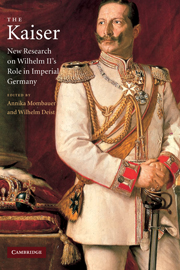Book contents
- Frontmatter
- Contents
- Notes on contributors
- Acknowledgements
- List of abbreviations
- Introduction
- Reflections on John Röhl: a Laudatio
- 1 Wilhelm II and ‘his’ navy, 1888–1918
- 2 Hollow-sounding jubilees: forms and effects of public self-display in Wilhelmine Germany
- 3 The Kaiser's elite? Wilhelm II and the Berlin administration, 1890–1914
- 4 Wilhelm, Waldersee, and the Boxer Rebellion
- 5 Dreams of a German Europe: Wilhelm II and the Treaty of Björkö of 1905
- 6 The uses of ‘friendship’. The ‘personal regime’ of Wilhelm II and Theodore Roosevelt, 1901–1909
- 7 Military diplomacy in a military monarchy? Wilhelm II's relations with the British service attachés in Berlin, 1903–1914
- 8 Wilhelm II as supreme warlord in the First World War
- 9 Germany's ‘last card’. Wilhelm II and the decision in favour of unrestricted submarine warfare in January 1917
- 10 Military culture, Wilhelm II, and the end of the monarchy in the First World War
- 11 Rathenau, Wilhelm II, and the perception of Wilhelminismus
- 12 Structure and agency in Wilhelmine Germany: the history of the German Empire – past, present, and future
- Index
1 - Wilhelm II and ‘his’ navy, 1888–1918
Published online by Cambridge University Press: 24 July 2009
- Frontmatter
- Contents
- Notes on contributors
- Acknowledgements
- List of abbreviations
- Introduction
- Reflections on John Röhl: a Laudatio
- 1 Wilhelm II and ‘his’ navy, 1888–1918
- 2 Hollow-sounding jubilees: forms and effects of public self-display in Wilhelmine Germany
- 3 The Kaiser's elite? Wilhelm II and the Berlin administration, 1890–1914
- 4 Wilhelm, Waldersee, and the Boxer Rebellion
- 5 Dreams of a German Europe: Wilhelm II and the Treaty of Björkö of 1905
- 6 The uses of ‘friendship’. The ‘personal regime’ of Wilhelm II and Theodore Roosevelt, 1901–1909
- 7 Military diplomacy in a military monarchy? Wilhelm II's relations with the British service attachés in Berlin, 1903–1914
- 8 Wilhelm II as supreme warlord in the First World War
- 9 Germany's ‘last card’. Wilhelm II and the decision in favour of unrestricted submarine warfare in January 1917
- 10 Military culture, Wilhelm II, and the end of the monarchy in the First World War
- 11 Rathenau, Wilhelm II, and the perception of Wilhelminismus
- 12 Structure and agency in Wilhelmine Germany: the history of the German Empire – past, present, and future
- Index
Summary
The uniform that the German Kaiser probably most loved was that of a British Admiral of the Fleet. Already as a child, when he had visited naval dockyards in Britain and Nelson's flagship Victory with his parents, he had been fascinated by the Royal Navy and both its great history and its achievements in making Britain the world's most powerful state and the supreme naval power in the nineteenth century. In order to emphasize his affection for the Royal Navy as well as the navy in general, one of his first acts after his appointment to the Royal Navy's highest rank was to have a picture painted showing him in this uniform and to present it to his grandmother, Queen Victoria. His pride and his vanity were so great that time and again he wore this uniform when he officially received the British ambassador to the court of Berlin. Pride and vanity were, however, only one aspect of Wilhelm's strange ‘love’ of the Royal Navy. More importantly, following his appointment, the German Kaiser now even felt entitled to interfere with British naval matters, and, as John Röhl has described in great detail in his biography of Wilhelm II, did in fact do so whenever possible, however trivial the matter was in the end.
Although German naval officers regarded this behaviour of their own ‘supreme warlord’ with deep contempt, generally speaking, the latter's passion for the navy, which he had obviously ‘inherited’ from his mother and which had steadily grown during his visits to England as a child, was indeed a blessing for the nation's ‘junior service’.
- Type
- Chapter
- Information
- The KaiserNew Research on Wilhelm II's Role in Imperial Germany, pp. 12 - 36Publisher: Cambridge University PressPrint publication year: 2003

